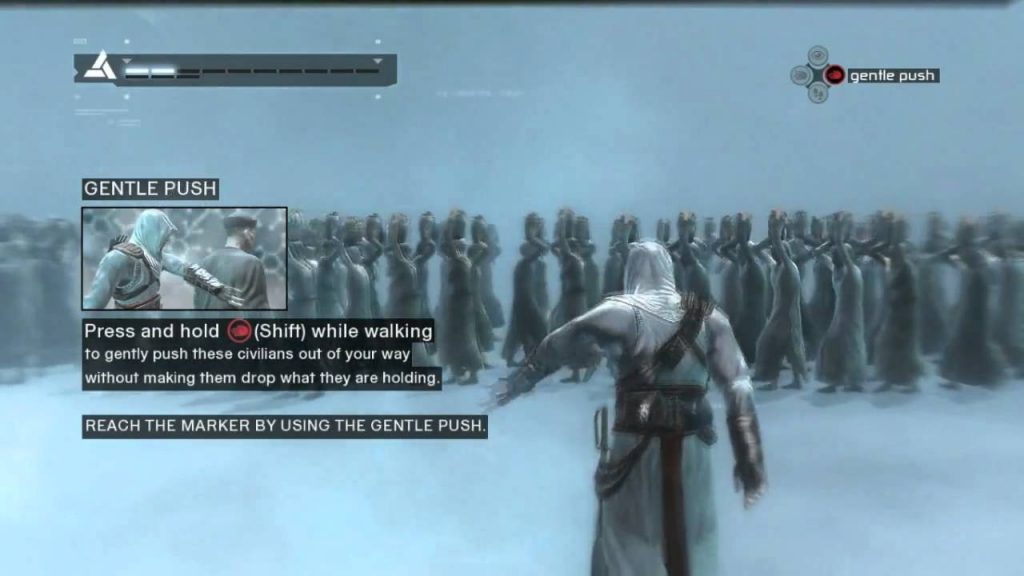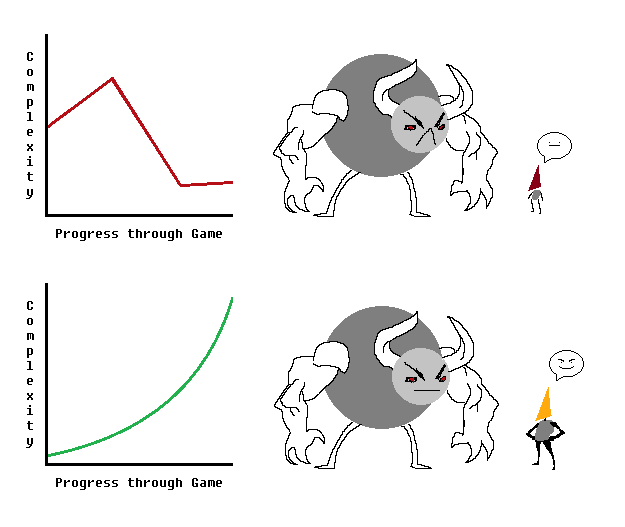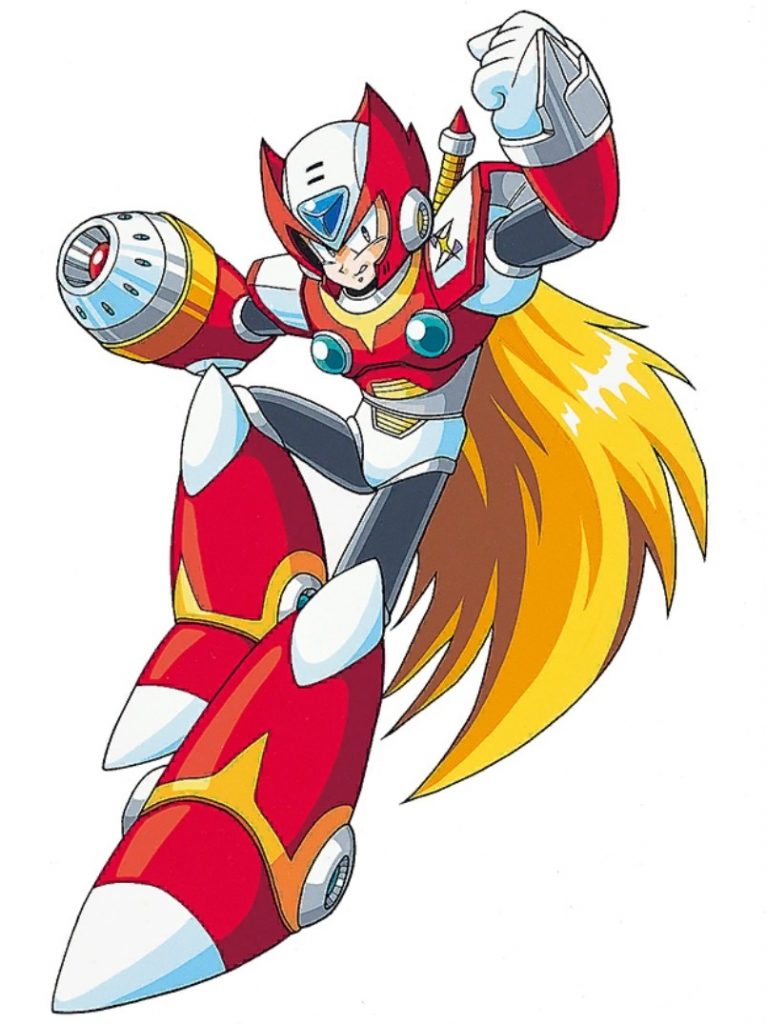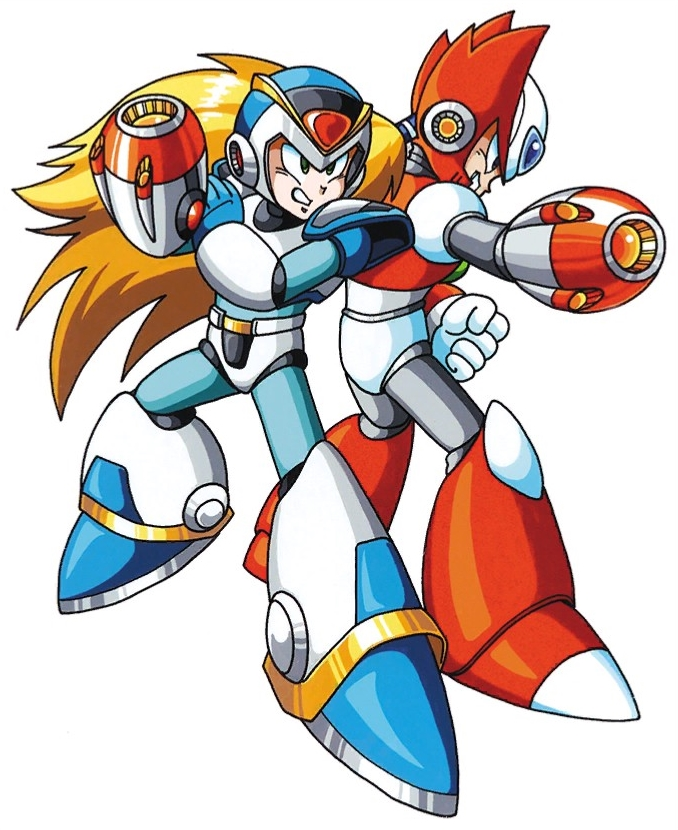If my interpretation of the class schedule is correct, this will be my penultimate post.
Since I don’t have time to draw out any doodles for an art related post, I figured I’d end on a game development post.
I’ve also been spending more time thinking about my game than I have my art as of late, so this is the topic I’m more prepared to talk about at length.
Introduction
Game design is extremely difficult.
There’s a lot of moving parts, and developing a game by yourself requires a great deal of discipline, careful planning, and LOTS of time and patience.
I’ve encountered my fair share of challenges while working on Deep Graves, and I wanted to elaborate on a few of them in this post.
This is gonna be a long post, so buckle up.
Game Design and Development Challenges
Managing Scope
This is related more so to game development than game design.
‘Scope’ refers to the general expectation for a game’s size. As stated by this excellent article from 2008,
“The scope of a project is its breadth and depth. What are you making, and how complex does it have to be to achieve what you want?” (Portnow).
Failing to plan and subsequently manage the scope of my game has been one of the biggest factors in terms of exhausting my game development energy.
I didn’t know what scope was until after I was knee-deep in the development of Deep Graves. Although, to be fair, I’m not sure prior knowledge would have changed much about the current scope of the game – I’m really stubborn.
Still, if there’s one piece of advice I can offer to those of you who may be interested in developing a game of their own, it’s this:
PLAN AND MANAGE YOUR SCOPE VERY CAREFULLY.
Develop several small projects before developing a bigger one.
And if you’re like me – that is, too stubborn to manage or limit your scope, my second piece of advice is:
DO NOT WORK ALONE.
To clarify, I wouldn’t change anything about my situation.
I’m glad that I’m working on Deep Graves, I’m glad I’m making it a moderate-to-full-size JRPG, and I’m glad to be working on it alone.
Still, I wouldn’t recommend anyone to follow in my footsteps. Be smarter than me.
With the boring game development stuff out of the way, we can start talking about the fun stuff – game design!
The Importance of Gameplay
I’m a believer that gameplay should always be the top priority when it comes to designing a game.
That may seem fairly obvious – like telling someone they should focus on the type of paint they’re using while painting – but gameplay is often overlooked and underutilized in modern AAA video games.

many games employ the frequent use of cutscenes, which strip control away from the player.
Games are an interactive medium, so I think if you’re neglecting to focus on interactivity, you’re missing the point. I’m kind of a purist in this respect.
This means that the lore, plot, character development, and gameplay mechanics, should all be communicated through visuals or interactive elements, whenever it is possible to do so.
Challenges
As you might expect, this isn’t very easy to do. Delivering all of these concepts through gameplay requires a great deal of planning and creative problem solving.
It can be tempting to just explain everything in plain English (or whichever language you may speak), but that can break immersion and lead to players feeling frustrated and bored.
Nobody enjoys being treated like an idiot.

You could argue that this Assassin’s Creed text box originates from the Animus – the virtual reality that Desmond, the main character is experiencing – but that would also require players to believe that Desmond doesn’t know how to push people.
In any case, explaining gameplay concepts via dialogue or immersion breaking tutorial-related text boxes is much less exciting than experiencing and learning mechanics in real-time.
Intuitive Game Design
I try to respect player intelligence, and trust that, as long as I design the game carefully and intuitively, players will be able to figure out what to do, and/or how to do it.
But that statement brings up an important question.. How do I, as the developer, go about introducing players to gameplay concepts?
How do I go about designing the game “carefully and intuitively”?
The Invisible Hand of the Developer
There’s a quote from a video by Nerrel (whose channel I seriously cannot recommend enough) that I think deftly illustrates the role of game designers.
“This Missile Tank is a good example of how Metroid games are designed. Its placement out in the open misleads the player into thinking it might be easy to get – only for them to waste a minute of their time and leave disappointed.
But the developers didn’t do this just to be dicks. They knew that frustration would cause the player to remember this room, so that when they got the Grapple Beam, they’d be sure to come back and finally get the Tank – and in turn, be led right into the Wrecked Ship, the next area of the game.
In this way, the developer’s unseen hand guides players through the world. You know where you want to go, but not really why – and it’s important that the developer’s fingerprints remain invisible, so that the achievement of figuring things out can feel like your own” (Nerrel).
This example beautifully highlights how a seemingly innocuous element of a level’s design can actually be an extremely powerful tool for guiding player progression.
The map of Super Metroid is labyrinthian in nature, yet it’s rare for players to feel completely lost – in most cases, there’s a clear goal in mind, and it’s this careful use of game design that allows for Super Metroid‘s maze-like world to feel digestible.
Game design is essentially the art of using your invisible hand to push players in the right direction through your game, while making an effort to avoid leaving any fingerprints, which may cause the illusion to break, and the player’s immersion to break along with it.
“When you do things right, people won’t be sure you’ve done anything at all” (Nerrel, quoted from Futurama).
The Power of the Hallway
As illustrated in the above section, one way to introduce a mechanic is to force players into situations involving that mechanic.
In the case of Deep Graves, one example would be the first combat encounter. (Keep in mind that, as always, the specifics of these examples are subject to change.)
Deep Graves’ first encounter. non-optional.
I force the player into a narrow hallway patrolled by an enemy. This forces the player into combat, thereby teaching them how fights will be initiated, along with the basics of the game’s combat.
Based on the enemy’s movement and the surrounding level design, it seems like you should be able to sneak around the enemy, but you can’t.
My hope is that by tantalizing players with the thought of avoidance, they’ll be more likely to experiment with avoiding future unwanted encounters.
Deep Graves’ second encounter. entirely optional.
players must go out of their way to engage with this enemy.
The next slime the player encounters isn’t placed directly in their path, which shows players that some fights will be optional.
By this point, players will have likely realized that Deep Graves will not have random encounters – combat will be initiated by colliding with enemies throughout the overworld.
Deep Graves‘ third encounter. semi-optional.
I take this a step further with the third encounter, with an enemy that can be avoided only through careful timing, showing players that some fights are optional if carefully/skillfully avoided.
In each of these examples, your punishment for failing to avoid the monster (when possible) is practically non-existent.
You’re forced into a combat encounter with the weakest enemy type in the game. It’s almost impossible to lose.
In later areas, the stakes will be higher due to enemies being more dangerous, placing a greater emphasis on the player’s skill via movement and timing.
To some degree, you could consider navigating around enemies and choosing your battles in Deep Graves a gameplay mechanic, so I think it’s important that I make an effort to communicate the elements of this mechanic intuitively, through carefully designed sequences.
While I could certainly find a way for a side character to explain this element of gameplay without completely shattering immersion, it would still be lazy.
English is a language inherently limited to those who understand it.
Game design and visual storytelling have no language barrier.
Introducing Complexity with Enemy Variety
Of course, the player won’t be fighting slimes throughout the entirety of Deep Graves.
Assuming all goes well, the combat of Deep Graves should be fairly fast paced and very challenging, while still being fair and rewarding.
I intend to introduce enemy variety and complexity one step at a time, so as to not overwhelm players.
Each area should start simple. Enemies will use basic, relatively weak attacks. These basic attacks should also introduce players to the attack types most prevalent in the current area.
As players progress through an area, enemies will gradually become more difficult. They’ll get tougher (harder to kill), and stronger (more deadly).
Enemies will start dealing more damage, and may start inflicting status effects, like sleep, burn, poison, or paralysis.
Obviously, this method of progression is not something I came up with. Pretty much every game in existence does this – it’s what allows for the existence of a “final boss.”
If the player was simply thrown into an arena with the final boss, it wouldn’t be very “final” anymore – you have to build up to a climax.

as players become more comfortable with the game, you can start introducing mechanics and complexity at an accelerated rate. as such, the graph is slightly exponential, rather than linear.
My goal is to implement this traditional progression system without resorting to immersion breaking explanations or exposition.
I want the discovery of enemy complexity and weaknesses to feel natural.
Theming Through Gameplay
This method of building enemy complexity also services the game’s theming.
I have to be careful here – I don’t want to give away too much of the game’s story, characters, progression, or themes.
If these sections feel lacking in detail, there’s my excuse.
As you progress through an area, you’re inching ever-closer to the heart of that area’s corruption.
Enemies becoming more dangerous should compound the tension, as it builds to the climax (boss) of the area.
This will, paired with with level design and the visuals of the overworld, serve to deliver plot and lore elements.
Labs will inform players of the strange, forbidden experiments once performed there, villages will describe the lives of those who once lived in them, and so on.
Character Progression (More Theming)
The concept (theme) of ‘getting stronger’ is very common in RPGs and action games – it may as well be omnipresent.
‘Getting stronger’ is directly related to personal (player/character) progression, which most games of that type have.
becoming more like Zero is one of the main themes of Mega Man X.
In Mega Man X, you get upgrades that make you more powerful, and cause you to look more like Zero – the character both Mega Man and the player look up to.
In JRPGs, you constantly level up, gain new skills, get newer, stronger equipment, and defeat increasingly dangerous enemies.
Through level ups and class upgrades, I hope to deliver many of the game’s themes, specifically those related to each character’s internal conflict(s), much like Mega Man X does with its upgrades.
I’d like to speak more on this, but I don’t want to spoil the experience.
For me, it would kill some of the excitement of discovering whether or not I succeed in communicating these ideas through the game’s design.
Like I said before, explaining these concepts in plain English would be missing the point of implementing them in the format of a video game.
Conclusion
I’d try to take the points made here a bit further, but I’m exhausted, and not creative enough to come up with anything beyond what I’ve already said.
If you read through this whole post, thank you. If you only read through part of it, thank you. In any case, thank you for reading.
I appreciate the support I’ve received throughout the semester. I’ll be discussing the future of this blog in greater depth later this week, in the final blog post for the semester.
Sources
- Assassin’s Creed; Gentle Push Tutorial. (n.d.). [Screenshot]. Gamer Walkthroughs. http://gamerwalkthroughs.com/assassins-creed/prologue-tutorial/
- Capcom. (n.d.-a). Mega Man X and Zero [Illustration]. Megaman Knowledge Base. https://megaman.fandom.com/wiki/Armor_Parts_(Mega_Man_X)?file=MMXX%2526amp%253BZero.png
- Capcom. (n.d.). Mega Man X Armor Parts [Illustration]. Megaman Knowledge Base. https://megaman.fandom.com/wiki/Armor_Parts_(Mega_Man_X)?file=X1_xarmor.jpg
- Capcom. (n.d.-c). Mega Man Zero [Illustration]. Megaman Knowledge Base. https://megaman.fandom.com/wiki/Zero?file=X2_zero.jpg
- Kingdom Hearts; Sora, Donald, and Goofy. (2017, March 27). [Screenshot]. Hardcore Gamer. https://hardcoregamer.com/2017/03/27/review-kingdom-hearts-hd-1-5-2-5-remix/251923/
- Nerrel. (2018, September 23). Metroid: Where Nintendo went wrong (and right again) [Video]. YouTube. https://www.youtube.com/watch?v=vG3tCQHB5Rw&feature=youtu.be
- Portnow, J. P. (08–03-11). Scope: A Lesson in Game Design- GameCareerGuide.com. Game Career Guide. https://www.gamecareerguide.com/features/508/scope_a_lesson_in_game_design.php
Disclaimer
All information in these posts is my own words, unless explicitly stated otherwise. None of this information is quoted, nor paraphrased, unless explicitly stated otherwise. Any similarities between my own words, and the informative sources/hyperlinks provided is purely coincidental, unless explicitly stated otherwise.
In any case where I am using someone else’s words (or imagery), the source will be cited internally, with a link to that source provided either within the internal citation, at the end of the post under “Sources,” or both.




April 27, 2021 at 10:01 pm
Game design is entirely its own beast and, like you said, takes a lot of effort and patience. Personally, I’ve been “developing” ideas for my own game for several years now. My game has taken on many different forms and iterations. Finally, I’m getting some of the world building and lore down. I know after graduation, I’m going to dedicate more time to the game I’m working on. Great article, it really made me think about game development.
April 27, 2021 at 11:06 pm
Deep Graves has been an idea bouncing around in my head since 2018, and quite frankly, I’ve still not finished that much of it. It’s a long, arduous process.
Still, I really love the problem solving aspect of game design. Finding creative ways to implement mechanics or aspects of character development into gameplay, and limiting the amount of supplementary dialogue is really satisfying.
Best of luck to you! I hope to see or hear more about your game in the future.
August 19, 2023 at 8:45 am
“Their content. The prices are reasonable and brianssclub.cm have excellent results
February 12, 2024 at 10:25 am
Through steadfast dedication, a foundation has been laid for individuals to unite, bond, prosper, and mutually ignite inspiration. Serving as a positive symbol, Briansclub underscores the potency of community and the potential for nurturing positive transformation.